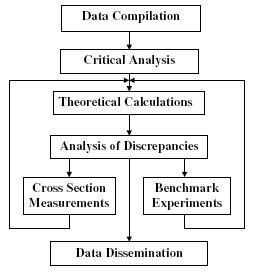
Evaluation procedure
The evaluation procedure consists of the following generally established steps. Firstly, a search of the literature and of nuclear data bases is made to compile relevant experimental data. Data published only as graphs are digitized. Then, data from different sources are compared and the reported experimental conditions and errors assigned to the data are examined. Based on this, the apparently reliable experimental points are critically selected. Free parameters of the theoretical model, which involve appropriate physics for the given scattering process, are then fitted in the limits of reasonable physical constraints. The model calculations are finally used to produce the optimal theoretical differential cross section, in a statistical sense. Thus, the data measured under different experimental conditions at different scattering angles become incorporated into the framework of the unified theoretical approach. The final stage is to compare the calculated curves to the experimental points and analyse the revealed discrepancies. If no explanation for any disagreement can be found, then a new measurement of the critical points should be made. The following scheme outlines the procedure.
